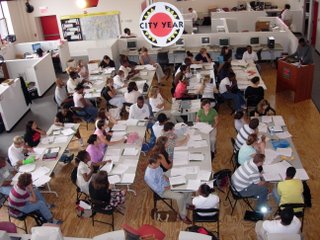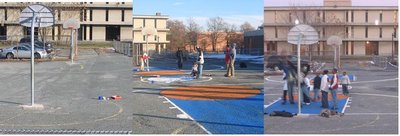Thursday, October 26, 2006
Basic Training Academy: Retreat


The best part of BTA is the retreat, BTR (Basic Training Retreat). We all go away as a staff and corps to a camp, usually in Maryland, and fill our time with more intimate trainings for working with and getting to know our new teammates from different backgrounds. The first night during “Community Time”, one of the corps members started a dance party. This consisted of everybody sharing and swapping dance moves. There was no alcohol and all the lights were on, yet the room was full of people teaching and learning dance moves even though they still didn’t know each other well. The next night was the talent show or the “no-talent show” as we like to call it to convey the idea that it is more for fun and less about competitive talent. This year there was cello and piano playing, spoken word poetry, stand-up comedy, freestyle hip-hop, and DANCING!!! The last “performance” was a few of the girls who started the dancing the night before. They asked all those who participated the previous night to come up and dance to showoff what they learned. This led to pretty much the whole room just dancing. There was a “Soul Train” line with the staff and corps just having a ball. It got me excited for the year and serving with this group of young people. Partially because I just love dancing, but mainly because this and other times throughout training reveal that our corps this year is just full of people ready to jump-in headfirst and make the most out of every experience.
Wednesday, October 25, 2006
Basic Training Academy: Immersion Excursion

The first month of the service year for a new City Year corps member is Basic Training Academy (or BTA in City Year lingo). We participate in trainings for pretty much anything and everything we will face during our year of service. Some of the trainings include “Introduction to Washington, DC and its History,” “Behavior Management in a Classroom,” and many team-specific trainings such as how to deliver our HIV/AIDS “Making Proud Choices” curriculum to middle and high school students.
My favorite training this year was the “Immersion Excursion.” In groups, corps members explored two DC neighborhoods to talk with residents and learn more about those specific communities. It’s the first chance corps members have to walk around and learn more about the neighborhoods they will be serving in. Before leaving the office, the facilitator talked about how DC is a city divided between the haves and have-nots. My group’s exploration of the Northeast neighborhoods around the Brookland/CUA Metro Station and the next metro station at Rhode Island Avenue made that comparison very clear. Catholic and Trinity Universities are both located near the Brookland/CUA Metro Station. Most of the green areas around the roads and sidewalks are well-maintained. There are also a number of small restaurants and cafés catering to the college students, who were mostly white. A corps member in my group was a DC native, who had spent significant time in Northeast Washington. He walked us through some residential streets and showed us that the area right around the Brookland/CUA Metro Station reflects and caters to the college community and not to the overall neighborhood and its residents. The neighborhood around the Rhode Island Avenue Station was different and in contrast to the area around the Brookland/CUA Metro Station. Rhode Island Avenue is a major traffic artery that runs through Northeast Washington. There was noticeably more trash and less upkeep around the roads and sidewalks compared to the first neighborhood we visited. There was a large strip mall with a grocery store, dollar store, clothing store, etc. We spoke with a resident who had lived in the neighborhood over 15 years and said, “The most pressing need here is having things for kids to do after school. When kids or teenagers have too much unstructured free time and outlets for constructive uses of their time are not available, they are more likely to get persuaded to get into trouble.” Even though it was comforting to know that a significant portion of CYDC’s (City Year Washington DC) service is in after-school programs around the District, simply the surface differences between two communities so near one another was unsettling.
City Year Washington DC – Back Again for a Second Year

I want to give a first-hand account of what it’s like to serve for a year with City Year Washington, DC. For those of you who are unfamiliar with the National Service movement, City Year is a full-time AmeriCorps program , which is like the domestic Peace Corps so instead of doing service in another country, you serve here in the United States. City Year’s focus is specifically on the power of young people to make long-term improvements for our country; thus, all 1200 City Year Corps Members across the country are between 17-24 years old. This is my second year serving in DC where the goals are to improve the community, develop young leaders, and help children and youth succeed. We try to achieve these goals through the following programs: drug and alcohol prevention education; HIV and AIDS prevention education; a 15-week leadership development and service-learning program for middle school students; tutoring in math and literacy for all ages; and bringing community members together to improve schools, parks, and community centers through physical service. We have one team of corps members dedicated to each of these 5 programs.
Last year I was a member of the AOL Civic Engagement team and we organized monthly service projects throughout DC to engage local residents from different parts of the city in service. Working on and planning a service day last year at Bowen Elementary in Southwest Washington was one the best experiences I have had at City Year! That day I led a small project with 7 volunteers painting the school’s mascot and regulation lines on the playground’s basketball court. Before we were even finished on that Saturday afternoon, neighborhood kids and students of the school were surrounding the playground anxiously waiting to play on their new court. One of the neighborhood kids said, “Wow, this is so cool! I wish this was at my school.” I saw the Bowen students glow with pride that this was their school. Hopefully, their pride in the court and school continued after we left and led to more pride in and respect for the education they receive there. This experience, witnessing a direct positive impact on children, significantly influenced my decision to return for a second year of service.